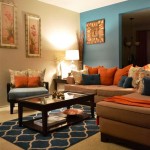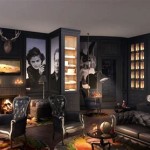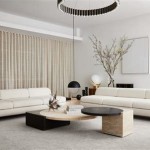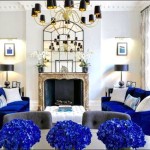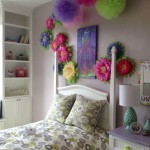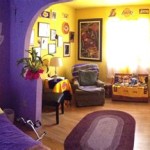How To Decorate a Big Room
Decorating a large room presents unique opportunities and challenges. The expansive space allows for creative freedom in layout and design, but it also requires careful planning to avoid a feeling of emptiness or visual disconnect. Effectively decorating a large room hinges on understanding scale, balance, and flow, ensuring the space is both aesthetically pleasing and functionally practical.
The initial step in decorating a large room involves assessing its existing characteristics. This includes evaluating the natural light sources, architectural features like windows and fireplaces, and the room's intended purpose. Understanding these elements provides a foundation for making informed decisions about color palettes, furniture arrangements, and overall design style.
Large rooms often suffer from a lack of visual cohesion. Careful consideration must be given to creating distinct zones within the space, each serving a specific purpose. These zones can be delineated using furniture placement, area rugs, and variations in lighting. The strategic implementation of these elements helps to break up the large expanse and establish a sense of intimacy within different areas of the room.
Scale is Key: Choosing Furniture and Decor
One of the most common mistakes in decorating a large room is using furniture that is too small. Standard-sized sofas and chairs can appear lost in a vast space, creating an unbalanced and awkward look. Opting for larger, more substantial pieces is crucial to achieving a sense of proportion and visual harmony.
Consider investing in oversized sectionals, large coffee tables, and generously scaled armchairs. These items help to fill the space and create a more inviting and comfortable atmosphere. When selecting artwork and accessories, prioritize larger pieces that can hold their own against the backdrop of the large room. A collection of smaller items might get visually lost, so focus on making a statement with fewer, more impactful pieces.
The height of furniture is equally important. Tall bookshelves, floor lamps, and decorative plants can help to fill vertical space and draw the eye upward, preventing the room from feeling too flat and horizontal. The addition of architectural details, such as crown molding or wainscoting, can also contribute to a sense of verticality and visual interest.
The choice of furniture materials plays a significant role in the overall aesthetic. Opting for heavier, more textured fabrics like velvet, leather, or bouclé can add visual weight and warmth to the room. Conversely, lighter, more delicate fabrics might be more appropriate for a room with abundant natural light and a more minimalist design aesthetic. The selection should reflect the intended purpose and the overall design concept, striking a balance between visual appeal and tactile comfort.
Incorporating a variety of textures is crucial for adding depth and visual interest to a large room. Mixing different materials, such as wood, metal, glass, and fabric, creates a more dynamic and engaging space. Consider adding a woven rug, a leather ottoman, and metal lamps to create a layered and visually rich environment.
Creating Zones for Functionality and Visual Appeal
Dividing a large room into distinct zones is essential for creating a functional and aesthetically pleasing space. This can be achieved through various methods, including furniture placement, area rugs, and changes in flooring. The key is to define each zone clearly while maintaining a cohesive overall design.
For example, a large living room might be divided into a conversation area, a reading nook, and a home office space. The conversation area could be defined by a large sectional sofa, a coffee table, and a pair of armchairs, all arranged around a central focal point like a fireplace or a large piece of artwork. The reading nook could be created with a comfortable armchair, a floor lamp, and a small side table, creating a cozy and inviting space for relaxation.
Area rugs are a particularly effective tool for defining zones within a large room. A large rug can anchor a seating area, visually separating it from other areas of the room. Using different rug patterns and colors can also help to differentiate zones and create visual interest. Consider using a bold patterned rug in the conversation area and a more neutral rug in the reading nook.
Changes in flooring can also be used to delineate zones. For example, a transition from hardwood flooring to tile or carpeting can visually separate a kitchen area from a living room area. This technique is particularly effective in open-concept spaces where there are few physical barriers between different areas of the room. However, the flooring choices need to be cohesive with the overall design.
The use of screens, room dividers, or shelving units can also effectively create distinct zones within a large room. These elements provide a physical barrier, offering privacy and defining boundaries. A decorative screen can add visual interest and act as a focal point, while a shelving unit can provide storage and display space while simultaneously dividing the room.
Lighting plays a crucial role in defining zones and creating ambiance. Different types of lighting can be used to highlight specific areas and create a sense of intimacy. Ambient lighting, such as recessed lighting or chandeliers, provides overall illumination. Task lighting, such as table lamps or floor lamps, provides focused light for specific activities. Accent lighting, such as spotlights or sconces, highlights architectural features or artwork.
Color, Light, and Texture: Establishing Mood and Atmosphere
The color palette used in a large room significantly impacts the overall mood and atmosphere. Light, neutral colors can create a sense of spaciousness and airiness, while darker, richer colors can create a sense of intimacy and warmth. The choice of color palette should be based on the room's intended purpose and the desired emotional response.
When using light colors in a large room, it is important to add depth and interest through the use of texture and accessories. Layering different shades of a single color can create a subtle but effective visual effect. For example, a room painted in light gray could be accented with pillows, throws, and artwork in varying shades of gray and white.
Darker colors can be particularly effective in a large room, creating a sense of drama and sophistication. However, it is important to use dark colors judiciously, as they can make a room feel smaller and more enclosed. Balancing dark colors with lighter accents and ample natural light is crucial for maintaining a sense of openness.
The amount of natural light available in a room also influences the choice of color palette. Rooms with abundant natural light can often handle darker colors more effectively than rooms with limited natural light. In rooms with limited natural light, it is best to stick to lighter colors and maximize the use of artificial lighting.
Mirrors are a valuable tool for enhancing natural light and creating the illusion of space in a large room. Strategically placing mirrors can reflect light and visually expand the room's dimensions. A large mirror placed opposite a window can effectively double the perceived amount of natural light.
Window treatments play a vital role in controlling natural light and adding visual interest to a large room. Sheer curtains can filter light and create a soft, airy atmosphere, while heavier drapes can block out light and provide privacy. The choice of window treatments should be based on the room's intended purpose and the desired level of light control.
In addition to color and light, texture is crucial for creating a visually rich and engaging space. Incorporating a variety of textures, such as wood, metal, glass, and fabric, adds depth and dimension to the room. Consider adding a woven rug, a leather ottoman, and metal lamps to create a layered and visually interesting environment.

10 Tips For Styling Large Living Rooms Other Awkward Spaces The Inspired Room

9 Tips To Help Decorate Large Spaces Real Estate Hsa

13 Strategies For Making A Large Room Feel Comfortable

10 Tips For Styling Large Living Rooms Other Awkward Spaces The Inspired Room

13 Tricks To Decorating A Large Living Room

10 Tips For Styling Large Living Rooms Other Awkward Spaces The Inspired Room

How To Decorate A Large Living Room Ruggable Blog

Great Secrets Of Rooms Hints For Decorating A Large Space Sheknows

How To Decorate A Large Living Room Peninsula

10 Tips For Styling Large Living Rooms Other Awkward Spaces The Inspired Room


